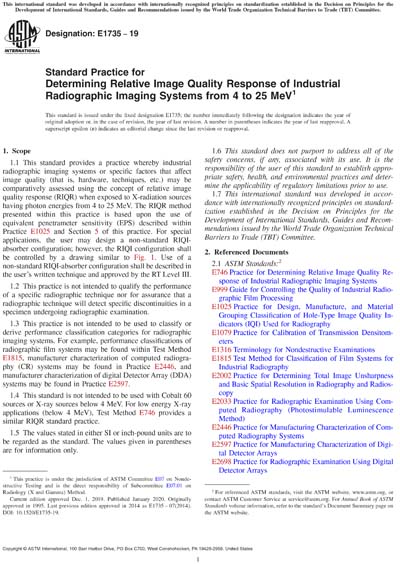Most recent
ASTM E1735-19
Standard Practice for Determining Relative Image Quality Response of Industrial Radiographic Imaging Systems from 4 to 25 MeV
1.1 This standard provides a practice whereby industrial radiographic imaging systems or specific factors that affect image quality (that is, hardware, techniques, etc.) may be comparatively assessed using the concept of relative image quality response (RIQR) when exposed to X-radiation sources having photon energies from 4 to 25 MeV. The RIQR method presented within this practice is based upon the use of equivalent penetrameter sensitivity (EPS) described within Practice E1025 and Section 5 of this practice. For special applications, the user may design a non-standard RIQI-absorber configuration; however, the RIQI configuration shall be controlled by a drawing similar to Fig. 1. Use of a non-standard RIQI-absorber configuration shall be described in the user’s written technique and approved by the RT Level III.
1.2 This practice is not intended to qualify the performance of a specific radiographic technique nor for assurance that a radiographic technique will detect specific discontinuities in a specimen undergoing radiographic examination.
1.3 This practice is not intended to be used to classify or derive performance classification categories for radiographic imaging systems. For example, performance classifications of radiographic film systems may be found within Test Method E1815, manufacturer characterization of computed radiography (CR) systems may be found in Practice E2446, and manufacturer characterization of digital Detector Array (DDA) systems may be found in Practice E2597.
1.4 This standard is not intended to be used with Cobalt 60 sources or X-ray sources below 4 MeV. For low energy X-ray applications (below 4 MeV), Test Method E746 provides a similar RIQR standard practice.
1.5 The values stated in either SI or inch-pound units are to be regarded as the standard. The values given in parentheses are for information only.
1.6 This standard does not purport to address all of the safety concerns, if any, associated with its use. It is the responsibility of the user of this standard to establish appropriate safety, health, and environmental practices and determine the applicability of regulatory limitations prior to use.
1.7 This international standard was developed in accordance with internationally recognized principles on standardization established in the Decision on Principles for the Development of International Standards, Guides and Recommendations issued by the World Trade Organization Technical Barriers to Trade (TBT) Committee.
Content Provider
ASTM International [astm]






